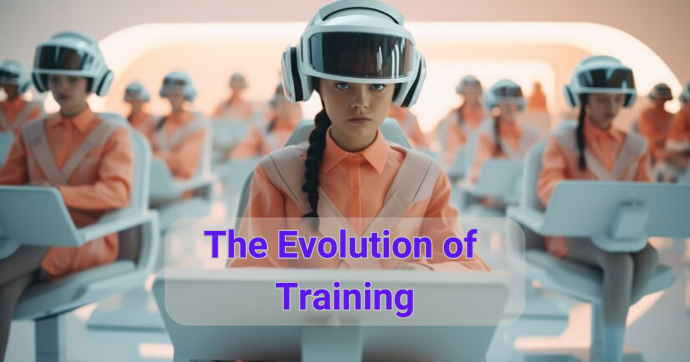Remember those days of flipping through dusty textbooks or sitting through endless lectures? Thankfully, the world of training is evolving rapidly, and Extended Reality (XR) is at the forefront of this exciting transformation.
XR, which encompasses Virtual Reality (VR), Augmented Reality (AR), and Mixed Reality (MR), is changing the way we learn by creating immersive and interactive experiences that make training more engaging, effective, and accessible than ever before.
Virtual Reality (VR): Stepping into Simulated Worlds
Imagine practicing a complex medical procedure in a virtual operating room, or exploring the depths of the ocean without leaving the comfort of your training facility. VR creates a completely immersive environment where learners can actively participate in simulated scenarios. This allows for:
- Safe Practice: VR environments provide a safe space to practice potentially dangerous tasks, like handling hazardous materials or operating heavy machinery, without any risk of real-world consequences.
- Enhanced Engagement: VR training is inherently interactive and captivating, keeping learners engaged and motivated throughout the learning process.
- Improved Retention: Studies have shown that VR training can lead to better knowledge retention compared to traditional methods.
Bringing The Digital World to Life with Augmented Reality (AR)
AR overlays digital information onto the real world, creating a blended learning experience. Imagine a mechanic seeing repair instructions superimposed on a real engine, or a pilot viewing flight data displayed on their windshield. AR offers several advantages:
- Contextual Learning: AR allows learners to apply their knowledge in a real-world setting, making it easier to transfer newly acquired skills to practical situations.
- Hands-on Training: AR can provide step-by-step instructions and guidance while learners perform tasks in the real world, enhancing their learning experience.
- Reduced Costs: AR eliminates the need for expensive physical simulations or mockups, making it a more cost-effective training solution.
Merging the Real and Virtual: Mixed Reality (MR) Bridges the Gap
MR combines elements of both VR and AR, creating a hybrid environment where virtual objects interact with the physical world. Imagine a surgeon seeing a patient’s anatomy overlaid onto their real body during surgery. MR offers unique benefits like:
- Spatial Awareness: Learners can interact with virtual objects in a real-world space, providing a more natural and intuitive learning experience.
- Enhanced Collaboration: MR allows multiple learners to collaborate with each other and manipulate virtual objects in a shared space, regardless of their physical location.
- Real-time Feedback: MR can provide real-time feedback on learner performance, allowing for immediate adjustments and course corrections.
Learning Goes Beyond Textbooks: The Rise of Extended Reality (XR) in Education
Imagine a classroom where students aren’t just reading about dinosaurs, they’re exploring a virtual prehistoric world! No longer confined to pages, the wonders of the Amazon rainforest or the complexities of photosynthesis can come alive right in front of their eyes. This isn’t science fiction – it’s the exciting reality of Extended Reality (XR) in education. XR, a powerful blend of virtual reality (VR), augmented reality (AR), and mixed reality (MR), is revolutionizing the way we teach and learn.
What is XR and How is it Different?
Let’s break down the different aspects of XR:
- Virtual Reality (VR): Imagine a completely immersive experience, where students can be transported to any place or time. With a VR headset, they can explore the pyramids of Egypt, walk on the moon, or even dissect a virtual frog!
- Augmented Reality (AR): AR changes digital elements onto the real elements. Students can see 3D models of historical figures floating in the classroom or watch the solar system come alive on their desks through tablets or phones.
- Mixed Reality (MR): MR combines elements of both VR and AR, creating a blend of real and virtual worlds. Imagine students collaborating on a virtual project right in front of them, using special glasses or headsets.
Why is XR Perfect for Learning?
XR isn’t just about cool gadgets. It offers several distinct advantages over traditional learning methods:
- Enhanced Engagement: XR experiences are interactive and immersive, sparking a sense of wonder and curiosity in students. Learning becomes an adventure, not a chore!
- Improved Knowledge Retention: Studies show that students learn and retain information better through engaging experiences. Seeing and interacting with concepts firsthand helps them make deeper connections and understand complex topics more easily.
- Accessibility for All: XR can create an inclusive learning environment. Students with disabilities can participate in virtual field trips or simulations that might not be possible in the real world.
The Future of Education is Immersive
The potential of XR in education is vast. As technology continues to evolve, we can expect even more exciting applications, such as:
- Personalized Learning: XR allows teachers to tailor lessons to individual student needs and learning styles.
- Global Collaboration: Students can connect with others from around the world in virtual classrooms or collaborative projects.
- Practical Skills Development: XR can be used to simulate real-world scenarios, allowing students to practice skills like surgery, public speaking, or language learning in a safe and controlled environment.
The future of education is immersive, interactive, and accessible to all. With XR leading the charge, learning is no longer confined to textbooks and classrooms – it becomes a boundless exploration of knowledge and possibilities!
While traditional training methods still have their place, XR offers several advantages that make it a compelling choice for the future of learning:
- Increased Engagement: XR fosters a more engaging and interactive learning experience, leading to improved knowledge retention and skill development.
- Scalability: XR training modules can be easily scaled to accommodate a large number of learners, regardless of their location.
- Cost-Effectiveness: In the long run, XR training can be more cost-effective than traditional methods by reducing travel expenses and the need for physical training materials.
- Safety: XR allows learners to practice potentially dangerous tasks in a safe and risk-free environment.
Wrapping-up
XR is not just a passing fad; it’s a powerful tool that is transforming the way we learn. By embracing XR technologies, organizations can create a more engaging, effective, and accessible training experience for their employees, ultimately leading to a more skilled and productive workforce.
Read More-: CWS Technology Supersizes Your Digital Business’s Identity








